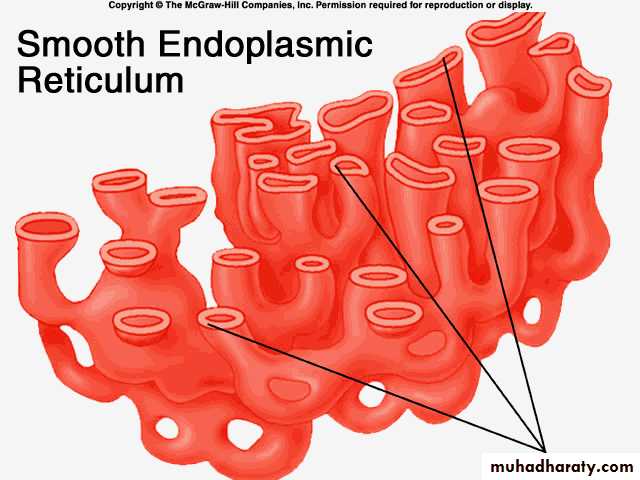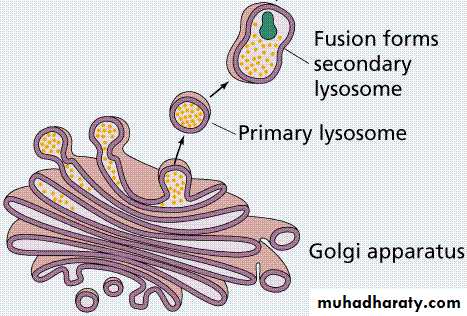بسم الله الرحمن الرحيم
Composition of The cellThe cytoplasm
Cytoplasm matrix fills the space between the plasma membrane and nucleus, it is composed of highly organized complex meshwork of elongated protein molecules responsible for many of the cell functions cytoplasmic matrix is essential to:Viscosity change.
Intracellular motion.
Amoeboid movement .
Spindle formation.
Cell division.
All of those functions depend on the cytoplasmic matrix , also the cytoplasm is the site of many fibrils differentiation found in specialized cells such as ;
keratin filament .
myofibrils.
microtubules.
Cytoplasm has salts are dissolved to form a solution and contains the soluble proteins and enzymes found in the cytoplasmic matrixs.
These proteins and enzymes constitute 20-25% of the total protein of the cell . Among the important soluble enzyme present in the matrix are those involved in glycolysis.
Cells have extensive sets of intracellular membranes, which together compose the endomembrane system. Scientists know that the endomembrane system includes the endoplasmic reticulum (ER), Mitochondria, Golgi apparatus, Ribosome, Nucleus and lysosomes. Vesicles also allow the exchange of membrane components with a cell's plasma membrane.
Endoplasmic reticulum:
A complicated system of membranous channels & vacuoles. The ER is the pathway for transporting lipids and proteins throughout the cell, it also provides the surface area for the chemical reaction that synthesizes lipids, it stores lipids and proteins until the cell needs them.Rough endoplasmic reticulum
Which is covered by ribosomes on its outer surface ,It is found in all cells except erythrocytes and it is especially a abundant in glandular cells, ex:salivary gland cells.
Only rough E.R has direct connections with the nuclear membrane .
Plasma cells which synthesize immunoglobulin .
• Functions of rough E.R:
• 1- Has a role in the synthesis of proteins to be exported outside the cell.• 2-Modification of newly formed polypeptides.
• 3-Assembly of multi-chain proteins.
• 4-Initial glycosylation of glycoprotein which mean , addition of glucose to the protein .
Smooth E.R
The smooth E.R is not associated with ribosomesand it is less common RER
Function of smooth E.R:
1-It is abundant in the liver and intestinal epithelium and seen to be involved in detoxification mechanisms of certain substances like alcohol toxins .2-It responsible for glycogen break down in the liver cells .
3-Responsible for lipid and cholesterol metabolism .
4-Involved in biosynthesis of steroid hormones (like hormones of adrenal gland).
5-It participated in the contraction process of muscle cells. So it called (sarcoplasmic reticulum).
Golgi apparatus (Golgi complex)
Morphologically, it consist of a stack of 3-20 curved sac,it receives protein and /or lipid filled vesicle that bud from E.R.
The vesicle are moves to the different location in the cells.
Some vesicles proceed to the plasma membrane where they discharge this contents to become a secretion, it is often said that the Golgi apparatus is involved in processing , packaging and secretion.
other vesicles that leave the Golgi apparatus are lysosomes .
Functions of Golgi apparatus :
1-Participate in the proteins synthesis.2-Initial proteolysis( cutting of protein ).
3-Terminating glycolyting and glycosylation .4-Phosphorylation (addition of the phosphate group).
5-Sulfation(addition of sulfa group).
6-Processing and storing glycoprotein.
7-Lipid metabolism
Ribosomes:
Ribosomes are closely involved in protein synthesis, where they serve as the structures that facilitate the joining of amino acids.They are play an active role in the complex process of protein synthesis.
The number of ribosomes in E. coli differs from approximately 7,000 to more than 25,000, depending on how rapidly the cell is multiplying.
The faster the cell is growing, the faster proteins are being synthesized and the greater the number of ribosomes needed. Each ribosome is composed of a large and a small subunit, which are made up of ribosomal proteins and ribosomal RNAs.
The relative size and density of ribosomes and their subunits is expressed as a distinct unit, S (for Svedberg), that reflects how fast they move when they are spun at very high speeds in an ultracentrifuge.
S coefficient: measurement the rate of sedimentation of ribosome unite under the effect of density gradient sedimentation.
Prokaryotic ribosomes are 70S ribosomes. Note that S units are not arithmetic; the 70S ribosome is composed of a 30S and a 50S subunit.
Prokaryote and eukaryotic ribosome differ in number of proteins and rRNA molecules they contain.
Prokaryotic ribosomes: are smaller and made up of three types of rRNA and 52 proteins.
Eukaryotic ribosomes are larger and consist of four types of rRNA and 82 proteins.
Also Prokaryotic ribosomes differ from the eukaryotic ribosomes, which are 80S.
Differences in the structures serve as targets for certain antibiotics, which preferentially bind to the 70S ribosome and thus inhibit protein synthesis in bacteria.
The Role of Ribosomes
**Ribosomes serve as the sites of translation, and**their structure facilitates the linking of one amino acid to another.
**Ribosomes bring each amino acid into a favorable position so that an enzyme can catalyze the formation of a peptide bond between them.
**The ribosome also helps to identify key sequences on the mRNA molecule, such as the point at which protein synthesis should be initiated.
Mitochondria (power houses)
Mitochondria are spherical or filamentous organelles 0.5-1µm in width and length about 10 µm their distribution in cell differs,they tend to accumulate in parts of the cytoplasm where metabolic activity is more,
such as the apical ends of ciliated cells
About 50% of this energy is stored as high energy phosphate bounds in ATP molecules , ATPase releases energy when required by the cell to perform type of work.
mitochondrial membrane: the inner membrane projects folds called cristae , between inner and outer mitochondrial membrane , the space called (inter membrane space ).
The compartment located between cristae , called inter-cristae , or matrix space is enclosed by the inner membrane. the cristae increase the internal surface area of mitochondria and contains enzyme and other components of oxidative phosphorylation and electron transport system.
The numbers of mitochondria are related to the metabolic activity of the cells in which they reside example : cardiac muscle, cells of some kidney tubules, mitochondrion are called the power houses of the cells , without them the cells are unable to extract significant amount of energy from the nutrient and oxygen.
C6H12O6+6O2 6H2O+6CO2
Some eukaryotic microorganisms (eg, Trichomonas vaginalis) lack mitochondria and contain instead a membrane-enclosed respiratory organelle called the hydrogenosome. Hydrogenosomes may have arisen by endosymbiosis and some have been identified that contain DNA and ribosomes. The hydrogenosome, while similar in size to mitochondria, lacks cristae and the enzymes of the tricarboxylic acid cycle.
Mitochondrial permeability:
• The outer membrane is freely permeable .• The inner membrane is rather impermeable ions and metabolites, therefore it must use carrier for passage of these material.
• Mitochondrial swelling is induced by several agents
• new mitochondria originate by division.
The Origins of Mitochondria and Chloroplasts
Mitochondria and chloroplasts tolerate such a striking similarity to prokaryotic cells that it is no wonder researcher have wondered for many decades that these organelles evolved from bacteria. The endosymbiont theory states that the ancestors of mitochondria and chloroplasts were bacteria exist in within other cells in a mutually beneficial partnership. The intracellular bacterium in such a partnership is called an endosymbiont: each partner became essential to the other, and the endosymbiont in the end lost key features such as a cell wall and the ability to replicate independently.*Mitochondria and chloroplasts, unlike other eukaryotic organelles, both carry some of the genetic information necessary for their function. These include genes for some of the ribosomal proteins and ribosomal RNAs that make up their 70S ribosomes.
*These ribosomes contrast with the typical 80S ribosomes that characterize eukaryotic cells and, in fact, are equivalent to the prokaryotic 70S ribosomes.
Several early observations have supported the endosymbiont theory.
*Another characteristic that supports the model that mitochondria and chloroplasts were once intracellular bacteria is the double membrane that surrounds these organelles. Present day endosymbionts retain their cytoplasmic membranes and live within membrane-bound compartments in their eukaryotic host cell.
Thank you
Lysosomes:Lysosomes are the membrane bounded vesicle produced by Golgi apparatus in animal cells and plant cells , lysosomes contains about 50 different degradative enzymes that can hydrolyze proteins , nucleic acids , carbohydrates and lipids , the most common enzymes are :
ribonuclease.
deoxyribonuclease.
phosphatase.
Phosphoprotien phosphatase.
Proteases.
Lipase.
Lysosome as the digestive system of the cell ,
1-degrade materials taken up from outside the cell (endocytosis).2-digest absolute components of the cell itself called (autodigestion ) example : the finger of a human embryo are at first webbed but they are freed from one another as a result of lysosomal action.
Types of Lysosomes
1-Primary Lysosomes: they are Lysosomes which have not entered into digestive stage , they are small in size , and also called storage granules .2-Secondary Lysosomes (Heterophagosome)
These are produced either from phagocytosis or endocytosis of foreign material by the cell. Actually within the cell the foreign bodies or extra-cellular substances are enclosed within the membrane after phagocytosis or endocytosis and these membrane bound structures are known as phagosomes or endosomes.In phagocytosis, specialized cells ex: macrophage taken up and degrade large particles including bacteria, cell debris and aged cells large particles are taken up in phagocytic vacuoles (phagosomes.
3- Autophagic vacuole (cytolysosome or autophagosome)
It is a special case in which lysosome digests a part of cell (e.g., mitochondria or portions of ER) by the process of autophagy. For example, liver cell shows numerous autophagosomes during starvation among which remnants of mitochondria occur. This is a mechanism by which the cell can achieve degradation of its own constituents without irreparable damage.The first step of autophagy appears to be the enclosure of an organelles (ex: mitochondria) in membrane derived from the E.R. The resulting vesicles (an autophagosomes) then fused with a Lysosomes and its contents are digested, in addition , autophagy plays an important role in development by participating in the remodeling of tissue during differentiation.
4-Residual bodies: are formed if the digestion incomplete. In some cells, ex: amoeba and other protozoa.
lysosomes having undigested material or debris are called residual bodies. These bodies are formed due to lack of certain enzymes in lysosomes.
These are rejected from the cell by exocytosis and some time in certain cells these bodies remain in cells for long time causing ageing.
These residual bodies also cause diseases in man such as fever, hepatitis, hypertension, congested heart failure, etc.
Function of Lysosomes:
1-The lysosomal enzyme can break all types of macromolecules into micro molecules such as: proteins into peptides.2-During development and body growth , Lysosomes are responsible for the removal of an unwanted tissue and waste product.
3-Digestion of extracellular materials ex: during bone development osteoclasts ((which are one type of cells present in bone tissue))
release enzyme of secondary Lysosomes by exocytosis to remolding the bone.
4-The acrosome of the sperm is a special type of lysosomes which plays an important role in the differentiation of the sperm.
5-Lysosomes in the white blood cells and macrophages are essential in the defense against bacteria and viruses
Peroxisomes (microbodies) :
Are small , membrane enclosed organelles that contains enzymes involved in a variety of metabolic reactions .
Function of Peroxisomes:
1-peroxisomes are microbodies that have enzymes for oxidizing certain organic substances with the formation of hydrogen peroxide (H2O2) .
RH2 +O2 R+H2O2
Because hydrogen peroxide is harmful to cell , peroxisome also contain the enzyme catalase decomposes hydrogen peroxide either , by converting into water or by using it to oxidizing another organic compound .
2H2O2 catalase 2H2O +O2
H2O2+AH2 2H2O+ A
2-peroxisomes are involved in lipid biosynthesis .3- Urate oxidase and other enzymes are related to the purine metabolism.
Vacuoles
A vacuole is a large membranous sac, vesicle is smaller than a vacuole. Animal cell have vacuoles, but they are much more prominent in plant cell, the vacuole present in protozoa are quite specialized , they are include contractile vacuole for ridding the cell of excess water and digestive vacuole for breaking down nutrients.Centrosome
The Centrosome of most animal cells contains pairs of centriols, the centriol is cylindrical structure consist of nine triplet microtubules , similar to the basal bodies of cilia and flagella.They are not found in plant cell; may be found in unicellular eukaryotes ,
The centriols play important role in cell division , one of the pair moves around to the opposite side of the nucleus from the other centriol, fibers spread from each centriol towards the centre of the cell and in some way act to move the chromosomes in the cell division (mitosis and meiosis) .
Cilia and flagella
Are motile projection of the plasma membrane that is responsible for movement of variety of eukaryotic cells . eukaryotic cilia and flagella are very similar structure ,The fundamental structure of both cilia and flagella is the axoneme which is composed of microtubules and their associated proteins.
Basal body
The intracellular end of the microtubules of cilia and flagella are fixed in basal body , which is similar in structure to a centriols and contains nine triplets of microtubules.Non- living inclusion bodies:
They are temporary component of the composed of one the following the metabolites:1-lipid : fat droplet , they are present mainly in adipose tissue , adrenal cortex and liver cells , they serve as a source of energy.
2-Glycogen: present in liver and skeletal muscle cell, they can be breakdown into glucose and used by the cell.
3-Proteins: they present either as a granules or as crystal example: in adrenal cells.
4-Pigments: they are deposit of colored substances ex:
A-Melanin: dark-brown pigments present in the skin , hair , retinae and some parts of the central nervous system .B-Lipofusin : yellow-brown pigments represent undigested substances of secondary Lysosomes they are present in liver cells .
C-Hemosidrin: gold- yellow in color ,they are the end product of Hb degradation of old red blood cells, they are present in the liver , spleen and bone marrow.














